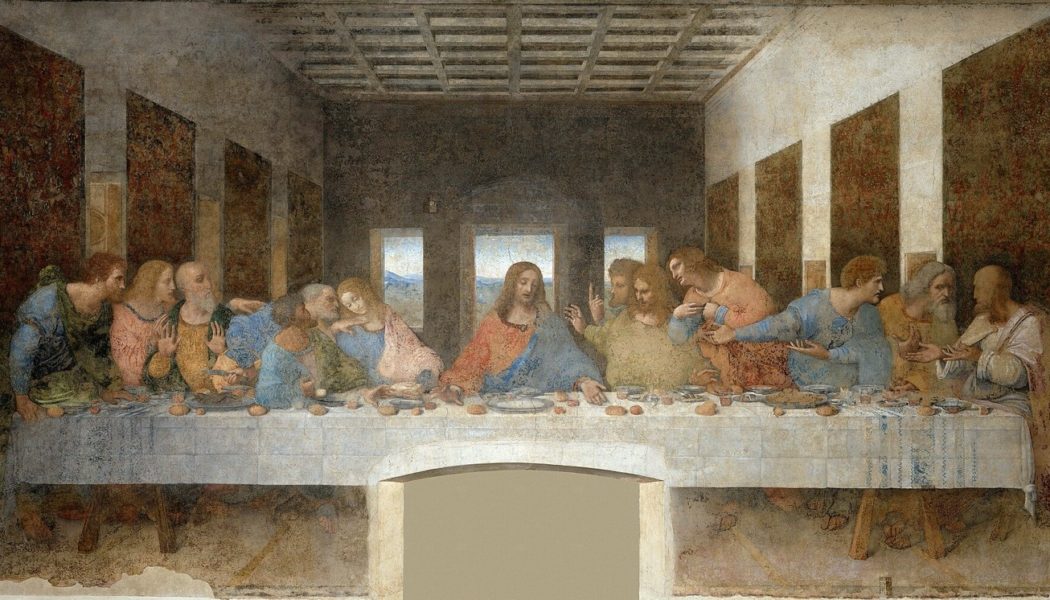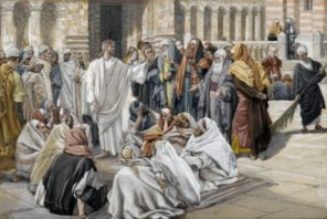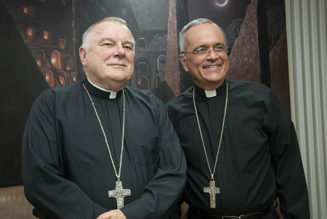With so much interest in the work of art, it’s worth reconsidering what exactly it depicts — and how contemplating it can help all of us grow in Eucharistic devotion. Here are five spiritually significant features of da Vinci’s masterpiece.
The Opening Ceremony of the 2024 Paris Olympics shocked Christians and others around the world by depicting a sexualized version of the Institution of the Eucharist.
In particular, the disturbing drag-queen display appropriated one of the most iconic depictions of this climactic moment from salvation history: Leonardo da Vinci’s 15th-century masterpiece, The Last Supper.
Ironically, although there are serious concerns that the ceremony was a clear instance of blasphemy, it may end up sparking renewed interest in the Renaissance artwork — and the sacrament it depicts. Google searches for da Vinci’s The Last Supper have skyrocketed in the past few days.
With so much interest in the work of art, it’s worth reconsidering what exactly it depicts — and how contemplating it can help all of us grow in Eucharistic devotion. Here are five spiritually significant features of da Vinci’s The Last Supper.
1. The painting depicts a shocking moment from the Last Supper.
The Last Supper was a common motif for the artists of da Vinci’s time. But the ingenious painter decided to focus on a specific moment high with human drama from the pivotal meal: the apostles’ reactions to Christ’s shocking revelation that one of them would betray him.
This moment is mentioned in all four versions of the Gospel, and some of the relevant passages come to life in da Vinci’s painting: “And as they reclined at table and were eating, Jesus said, ‘Amen, I say to you, one of you will betray me, one who is eating with me.’ They began to be distressed and to say to him, one by one, ‘Sure it is not I?’” (Mark 14:18-19); “‘And yet behold, the hand of the one who is to betray me is with me on the table’” (Luke 22: 21); “The disciples looked at one another, at a loss as to whom he meant” (John 13:22).
Like all great religious art, da Vinci’s The Last Supper starts with what God has already revealed in sacred Scripture and uses artistic expression to help viewers contemplate the depicted mysteries in new and fruitful ways. In the midst of da Vinci’s work on the painting, his friend and Franciscan friar Luca Pacioli called it “a symbol of man’s burning desire for salvation.”
2. Christ is the focus — spiritually and artistically.
Although the painting depicts the apostles’ various reactions to Christ’s announcement, they’re not the focal point; unsurprisingly for a painting about the Last Supper, Jesus is. Da Vinci went to great artistic lengths to draw viewers’ eyes to Christ, whose serene expression stands in sharp contrast to the chaos and commotion of the apostles around him.
The Italian painter achieved this focus through the use of “one-point perspective.” Christ’s right cheek, turned slightly to the side, is located at the “vanishing point” for all perspective lines, drawing all eyes first to the middle of the piece, where Jesus sits against the light backdrop of an open window. To aid him in keeping the singular focal point, da Vinci drove a nail into the middle of the canvas where Jesus’ head was painted and strung thread in different directions to maintain the same perspective throughout. While Jesus is not depicted with a halo, which some say means da Vinci denied his divinity, the Lord is painted wearing the traditional colors of blue and red, which signify both his human and divine natures.
Christ is in the middle, but in turn, his downward-turned face leads the viewer’s gaze down his left arm to his left hand, which is pointing to what appears to be a piece of bread: the Eucharist. The spiritual significance seems clear: In the midst of life’s trials and tribulation, our focus should be on Christ, who is present to us in the Eucharist.

3. The apostles’ reactions tell us who they are.
Although Jesus is the focus, da Vinci spared no detail in depicting the dramatic reactions of the apostles, which include fear, doubt and anger. The artist wrote that his intent was to unveil the various “movements of the soul” of the apostles at this fateful moment. The Twelve are identifiable by their various actions (although a 16th-century copy with their names written in also helpful), illustrating what the Gospel writers described in Scripture. Here are a few:
- St. John: Immediately to the left of Jesus (from the viewer’s perspective), the “beloved apostle” is “reclining at Jesus’ side” (John 13:23). We see him leaning away from Jesus, however, towards St. Peter, who we know “nodded to him to find out whom [Jesus] meant” would betray him.
- St. Peter: Da Vinci includes another significant detail about Peter, whose head is second from Jesus to the left: The apostle is holding a knife. This foreshadows what Peter would do soon after the meal ended, when Jesus is arrested in the Garden of Gethsemane, and Peter draws his blade and cuts off the ear of the high priest’s servant.
- Judas the Iscariot: Unlike some other depictions of the Last Supper, which have Judas at the edge of the table, da Vinci includes the betrayer (whose head is third to the left from Jesus) in the middle of the action and depicts his deceit more symbolically: Judas is leaning back into the shadows, his face obscured. Additionally, he is seen reaching for the same small vessel as Jesus, who said “he who has dipped his hand into the same dish with me is the one who will betray me” (Matthew 26:23).
Judas is also holding a bag of money, a likely reference to the 30 pieces of silver he was paid for betraying Christ. And he is knocking over a small cup of salt, a depiction of the origin story for the widespread superstition that spilling salt brings bad luck. - St. Thomas: Perhaps as a prefigurement of his doubtful reception of Christ’s resurrection, Thomas (whose head is immediately to the right of Jesus) has his finger raised to the sky, as if questioning how the Lord’s revelation of his betrayal could be possible.
- St. Phillip: Third to the right of Jesus, the ever-inquisitive Phillip is imploring Jesus for an explanation. We can almost see the words attributed in Scripture to the apostles in this shocking moment painted on his lips: “Surely it is not I?” (Mark 14:19).
4. A Trinitarian theme is detectable.
Da Vinci, of course, wasn’t just a painter. Among many other things, he was also a brilliant mathematician, and numbers play a big role in The Last Supper.
In particular, the No. 3 stands out. The apostles sit in groups of three, there are three windows behind the table, and the silhouette of Christ appears almost like a triangle. The reference here is likely to the Holy Trinity, of whom Christ is the second Person. Three can also represent divinity, heaven and wholeness, as three lines are the minimum needed to draw an enclosed shape, a triangle.
5. The painting adorns a place of prayer and community.
Da Vinci’s painted his masterpiece directly onto the wall of a refectory in the Convent of Santa Maria della Grazie (“Holy Mary of Grace”) in Milan, from 1495 to 1498. The room is where the Dominican friars ate their meals. Painted with Jesus and his apostles all on one side of the table, the mendicants down below were invited to gaze at the 15-by-29-foot painting during their silent meals and imagine themselves seated on the opposite side of the table.
We’re invited to do the same today. Visitors can certainly see The Last Supper, restored in 1998, in the Italian convent where it still remains. However, replicas of the iconic artwork, or at least variations on theme, are common in Catholic dining rooms and eating halls throughout the world.
The Opening Ceremony of the Olympics may have tried to mock the Last Supper, as represented in da Vinci’s work. But perhaps what happened in Paris will end up revitalizing interest in this powerful work of art — and in the Eucharistic scene that it so strikingly depicts.









